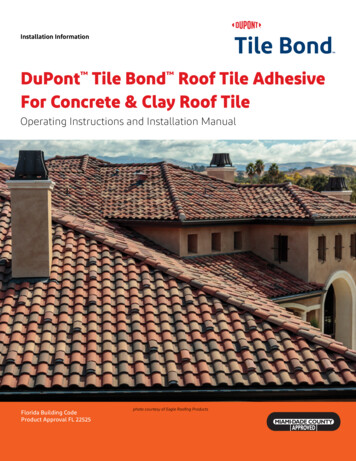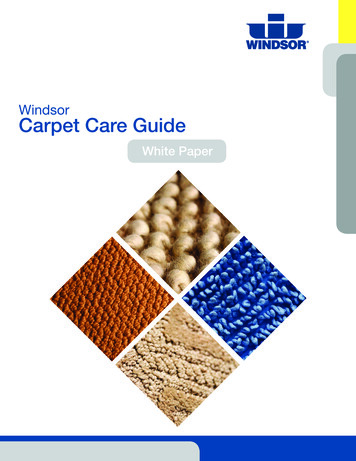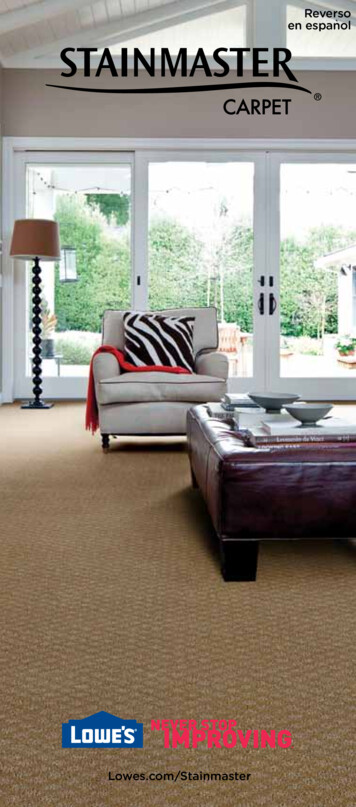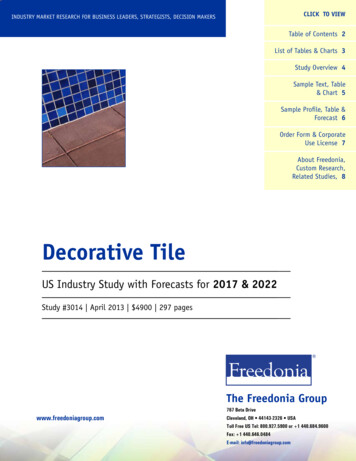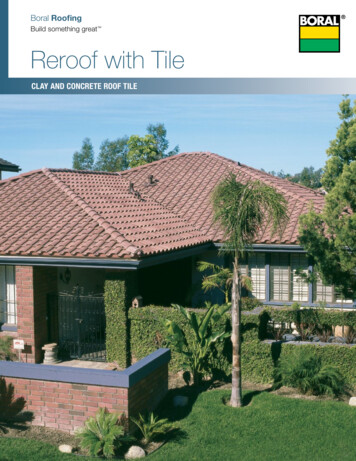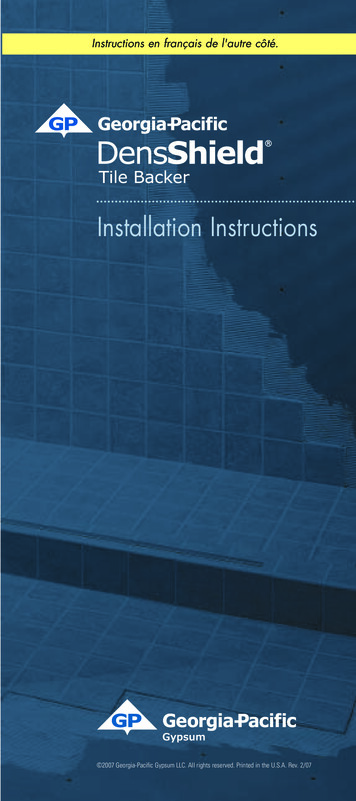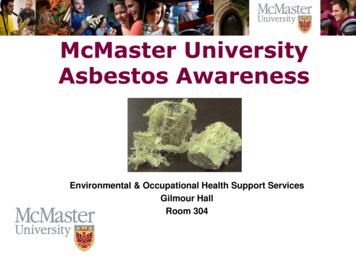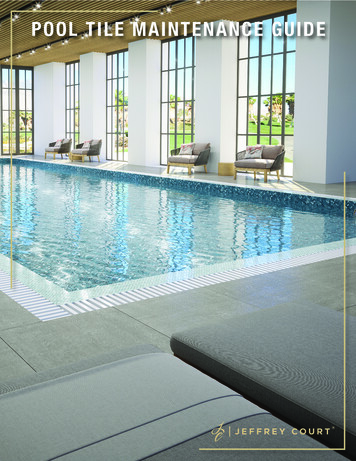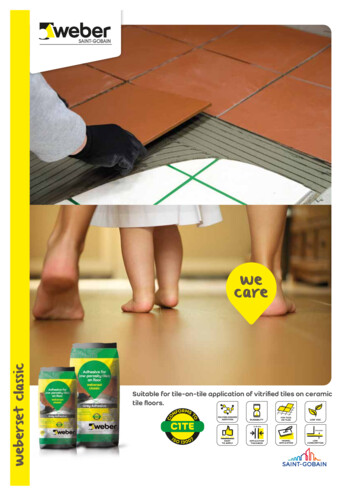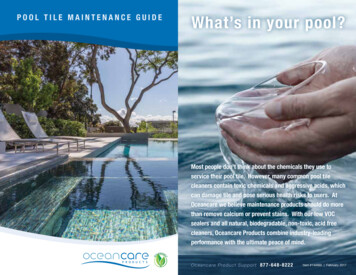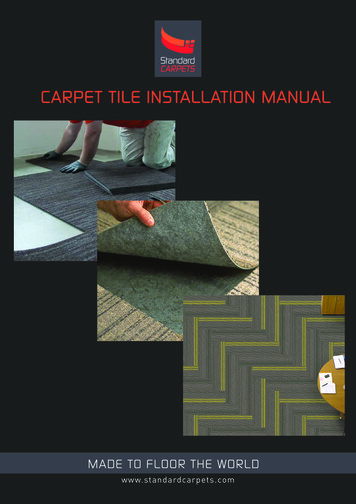
Transcription
CARPET TILE INSTALLATION MANUALwww.standardcarpets.com
TOOLS & MATERIALS1.2.3.4.5.6.7.8.9.10.11.12.Carpet KnifeUtility KnifeWall TrimmerCarpet ShearsNap Paint RollerTin ShearsHammers and MalletsCarpet Tile AdhesiveChalkMeasuring TapeStraight Edge ToolFirst Aid SuppliesStandard Carpets has adopted the Carpet & Rug Institutes (CRI) installationstandard, as a basic minimum industry guideline for the installation of its carpetproducts. This manual has been prepared to assist professional contractors toinstall Standard Carpets Modular Tiles. This instructions cover the importantcommon installation circumstances and it will help them understand the rightmethods of sub floor prepartion, adhesives and dos and don'ts.
FOREWORDProducts have unique characteristics and each installation projectshould be carefully evaluated to determine the proper application ofthis standard.Proper specification for carpet includes installation by a certifiedcarpet professionals and strict compliance with the installationguidelines set forth in the CRI Carpet Installation Standard, unlessotherwise specified by Standard Carpets, and also includes the use ofproper installation sundries.INSTALLATION REQUIREMENTSDue to the variation in tile size, shape, backing and installationmethods (monolithic,ashlar, quarter turn, etc.) follow the carpetmanufacturer’s recommendations.Notice – Contractor or Installation contractor is responsible forinspection of the product prior to installation. Standard Carpets willnot be responsible for visible defects after tiles have been installed.
PLANNINGProducts have unique characteristics and each installation project shouldbe carefully evaluated to determine the proper application of this standard.It is the responsibility of the contractor to verify few things before theinstallation.All facets of the installation are to be coordinated. A scale drawing ofthe area to be installed is required to determine type of carpet, carpetquantities, quantity per dye lot,installation method, cushions, adhesives,transition moldings, wall base types and other accessories, and to identifythe proper location of seams. On new construction, contractors need to have the architecturaldrawings that define the entire installation area with space names ornumbers and a finish schedule of flooring style, patterns, colors andinstallation methods. On existing structures, they need new measurements and shopdrawings.1. Floor PlanThe carpet shop drawing is required to contain the following information:· Name of the job, owner and installation company. On new constructionthe name of the general contractor and architectural firm are required.· Building address· Date of drawing· Scale· Floor number and location in building· Compass direction on each sheet· Drawing for each area to be carpeted (color coding is preferable)· Construction of substrate for each area· Required floor preparation, materials and quantities.· Type of installation for each area· Exact notations where dye lot changes occur· Type of installation for each area· Exact notations where dye lot changes occur
PLANNING CONTINUED.· Proper quantities of installation materials needed for each area includingbut not limited to:· Carpet needed for each area, length of pattern repeats, manufacturerpallet sequence (where applicable)· Specified adhesives per manufacturer instructions· Excess material in each area and how it is to be used· Seam layout of each area· Carpet pile or pattern direction for each area· Name of manufacturer, style, backing system and color of carpet for eacharea· Large scale drawings showing treatment of step areas or other detail work· Location and type of expansion joints and edge transitions.· Type of wall base in each area.2. Transitions of Other SurfacesWhere carpet transitions to other floor coverings, the carpet edges arerequired to be protected or covered with appropriate transition moldings.The edge of the hard surface flooring should not exceed a maximum of 1/16”higher than the total carpet thickness where no transition molding exists.3. Carpet Over Expansion JointsDo not install carpet over expansion joints. Expansion joints allowseparate substrate surfaces to expand and contract independently. Inaddition, do not install on any area of a floor that does not provide a stableand mechanically sound surface. This does not include cut or saw jointswithin a section of the floor. Non-stable/unsound substrate jointconditions are required to be addressed in strict accordance with theappropriate architectural drawing. If no expansion joint device is specifiedon the drawing, the building owner, owner’s representative, or otherresponsible party is required to be made aware that failure to addressexpansion joints will potentially result in installation failure, damage tothe carpet and/or safety concerns.
TESTINGThe Moisture Vapor Emission Rate, Relative Humidity & Alkalinitytesting must be performed to give an accurate assessment of theconcrete condition and the test results/data of each test shall be withinacceptable limits.Before direct glue-down, double-glue down, free floating carpettile systems and some stretch-in installations, the owner or generalcontractor, or their designated testing agent,is required to submit tothe flooring contractor a written report on the moisture and alkalinityconditions of the concrete substrates.Proper testing is essential for a successful installation and any deviationfrom these industry accepted test methods often results in an installationfailure and may void manufacturers’ warranties.NOTE: It is recommended that qualified independent third-party testingagencies be used for determining moisture and alkalinity conditionsof a concrete slab. Testing by an independent third-party specialist todetermine installation suitability is a prudent and necessary safeguardfor general contractors, owners, architects, flooring product providersand installation contractors to reduce the risk of concrete slab moisturerelated flooring problems. As a minimum, testing agencies or individualsare required to demonstrate verifiable experience in concrete moisturetesting or be certified by a recognized organization.
TESTING CONTINUED.1. Moisture Vapor Emission Rate (MVER) TestingMVER tests must be conducted in accordance with the current versionof ASTM F 1869, not to exceed manufacturer’s requirements (ASTMF1869 - Standard Test Method for Measuring Vapor Emission Rateof Concrete Sub floor Using Anhydrous Calcium Chloride).2. Relative Humidity (RH)TestingTesting for internal relative humidity of concrete slabs must beconducted in accordance with the current version of ASTM F2170,not to exceed manufacturer’s requirements (ASTM F2170 - StandardTest Method for Determining Relative Humidity in Concrete FloorSlabs Using In-Situ Probes).3. Testing for AlkalinityTesting the pH at the surface of a concrete slab must beconducted in accordance with the current version of ASTM F710,not to exceed manufacturer’s requirements (ASTM F710-StandardPractice for Preparing Concrete Floors to Receive Resilient Flooring).NOTE: Preparing the surface of a concrete slab for pH testing canbe problematical. Make sure, the concrete surface is adequatelycleaned of adhesives, curing compounds etc. When pH readings areless than 7, it may be an indication of a residue remaining on theconcrete surface. Also use care not to over clean the surface of theconcrete, consequently removing the (usually) thin layer ofcarbonation. This can result in pH readings 12.
SITE CONDITIONSProper site conditions as outlined in this section are essentialfor a successful installation and any deviation often results in aninstallation failure and may void manufacturers’ warranties.NOTE: Installing carpet before other trades have completed their workmay result in problems with: overall appearance, visible damage, soiling,adhesive failure, delamination and dimensional stability. These conditionsmay not be immediately evident.1. Substrate ConditionsCarpet is required to be installed over properly prepared substrates that aresuitable for the specific product and installation method selected. All cracks,holes and flooring irregularities are required to be repaired to ensure a flat,smooth substrate, prevent accelerated wear and telegraphing substrateirregularities.2. Ambient Temperature and Humidity Suitable SubstratesThe installation is not to begin until the HVAC system is operational and thefollowing conditions are maintained for at least 48 hours before, during and72 hours after completion. The carpet is to be installed when the indoortemperature is 65-95ºF (18-35ºC) with a maximum relative humidity of 65%.The substrate surface temperature should not be less than 65º F (18º C) attime of installation. Do not allow the temperature of indoor carpeted areasto fall below 50º F (10º C), regardless of the age of the installation.If these conditions are not attainable, contact the flooring manufacturer forapplications to warranty.NOTE: If the above conditions are not met, installations may be susceptible tomoisture related failures including but not limited to dew point condensation.3. VentilationDuring installation, maintain air circulation by operating the HVAC system atfull capacity.
TYPES OF FLOOR1. ConcreteConcrete must be cured, clean, dried and tested in accordance toPlanning Testing section of this document. If the carpet is to be installedusing an adhesive, the concrete should be free of dirt, grease, oil, curingor parting agents, and other contaminants, including sealers, that mayinterfere with the bonding of adhesive.NOTE: It is not recommended to chemically treat (abate) substrates.These chemicals are difficult to completely remove and will adverselyaffect new adhesive and carpet.Whenever a powdery or porous surface is encountered, a primer/sealercompatible with the adhesive should be used to provide a suitablesurface for the glue-down installation.NOTE: Any concrete floor, even when adequately cured and dry, canallow moisture vapor to pass through to its surface. Depending upon thetype of carpet and method of installation, the moisture emission rategreatly influences the long-term success of an installation. The use ofa properly installed, uncompromised, approved moisture membrane isessential in preventing moisture migration into and through a concreteslab.(Ref. ASTM F 710)Concrete that has been treated with a moisture mitigation system willrender the substrate non-porous. Before installation, a bond test isrecommended. If the bond test fails, the substrate must be adequatelyprepared to accept adhesive.3. WoodWood substrates are required to be structurally sound, flat, dry andsecurely anchored.Substrates, such as plywood, hardwood, particleboard, oriented strandboard, or other materials, are required to be flooring grade (APAapproved) and installed according to manufacturer specifications.Irregularities, imperfections and joints are required to be properlypatched and prepared. The use of a primer on the substrate will improvebond strength of the patch.Wood that is chemically treated to alter properties relating to outdoorexposure or flame resistance is not a suitable substrate for directglue-down applications. Floor covering adhesives would be subject tochemical degradation when applied to these surfaces.
TYPES OF FLOORCONTINUED.4. MetalIt is required that metal floors create a smooth, even plane, and be freeof grease, oil, soil and rust.5. Raised Access FlooringIt is required that raised access flooring be structurally sound, flat andproperly secured.For carpet tile installation, tile seams should be offset from access panelseams unlessotherwise specified.6. ResilientInstalling carpet over resilient flooring may be acceptable as long asthe resilient flooring is securely bonded to the substrate and all waxes,sealers, floor finishes and other foreign materials have been removed.It is not recommended to install over floating, perimeter bonded orcushion-backed sheet goods.NOTE: Some sheet vinyl, resilient tile and cut-back asphalt-based adhesivemay contain asbestos and/or crystalline silica. Recommended workpractices prohibit sanding, dry scraping, bead-blasting or mechanicallypulverizing resilient flooring, backing or lining felt.Do not use powered devices that create asbestos dust when removing“cut-back” or asphalt-based adhesives. Removal procedures must complywith federal, state and local government agency regulations coveringthe removal and disposal of asbestos-containing materials (ACM).7. Terrazzo, Ceramic, Marble, Slate and Other Nonporous SurfacesRemove surface finishes and abrade flooring surfaces to ensureadhesion. Grout lines must be filled and flush with flooring materialsurface. Ceramic or other surfaces may require the use of a primer toensure proper adhesion. Slate and brick surfaces may be too rough anduneven for most installations and may require the use of a self-leveleror smoothing before installing carpet. Attention must be given to the“open time” requirements of the adhesive manufacturer when adheringcarpet to these surfaces.
TYPES OF FLOOR CONTINUED.8. AsphaltFor approved flooring materials, it is required that asphalt surfaces beclean, dry, free from excessive oil and grease, and in good condition. Curenew asphalt for at least 90 days, or longer, depending upon weatherconditions.9. Painted SurfacesPainted surfaces may be suitable for adhesive application; however,bond tests are recommended. Glossy surfaces must be abraded prior toinstallation. Contact the adhesive manufacturer for requirements.
FLOOR PREPARATIONFloors are required to be structurally sound and free of foreignsubstances that may compromise the carpet or its installation.The subfloor must be rigid to stop modular carpet from cupping.Old carpet, under felt, loose laid vinyl, cushion backed vinyl andany old adhesive must be removed and floor scraped clean. A Clean floorFloor should be free from all dirt, dust and harmful materials. Beforeapplying adhesive sweep/mop and vacuum the subfloor to remove alldust. Patching compounds are required to be suitable for the intendedapplication. Select polymer-fortified patching compounds accordingto the carpet manufacturer’s instructions. (Refer to current version ofASTM E1155).NOTE: Patched areas may be porous and highly alkaline, which willprevent adequate adhesive bond. For best results, prime patchedareas. Consult patch manufacturer for primer recommendations andcompatibility with adhesives. A Dry floorAll floors must be dry. New concrete floors must be checked for moisturecontent as per Standard Carpets recommendations. Moisture contentmust not exceed levels as indicated in Planning Testing section ofthis document. If the moisture content is above the recommendedmaximum readings STOP and DO NOT PROCEED with the installation.Seek further advice from the contractor before proceeding. A Low pH floorThe subfloor should have an alkalinity level of between pH7 & pH9 to besuitable for carpet installation. Should the pH level be outside this rangeSTOP and DO NOT PROCEED with the installation. Seek further advicefrom the contractor before proceeding.
CARPET INSTALLATION1.Product AcclimationIt is recommended that carpet and installation materials be allowedto acclimate in the installation area for a minimum of 24 hours at atemperature of 65-95ºF (18-35ºC). Carpet must be adequately protectedfrom soil, dust, moisture and other contaminants. Followmanufacturer’s instructions for acclimation.2. LayoutTo ensure straight square installations, apply at least two perpendicularchalk lines onto the substrate (at a 90-degree angle to each other).These chalk lines should extend the entire length and width of the areato be covered. A laser line can be also utilized for this purpose. Thelocation and intersection point of the chalk lines should be determinedto achieve the design intent and reduce waste.NOTE: The intersection point mentioned above may or may not be inthe center of a room in order to achieve the design intent.3. GeneralIn setting up, a point in the room shall be determined from which modularcarpet can be laid to ensure that they are parallel to the longest wall.
CARPET INSTALLATION CONTINUED.3.1. Tiles InstallationDirectional arrows are printed on the back of all tiles.Determine the ‘arrow direction’ for the installation and make sure all tilesare installed in the same direction, unless chequerboard, ashlar or brickpattern is required. (see diagrams below).Start from the intersection point in the center of the floor and install thefirst line of tiles along the center line. Install the second line of tiles alongthe perpendicular center line. Keep all tiles exactly on the chalk lines. Fit thetiles snugly next to each other. Do not force the tiles. Press the tiles firmlyonto the floor when properly positioned. Tiles can be removed from the floorat any time for realignment, extra care should be taken when installing intopermanent adhesive.
CARPET INSTALLATION CONTINUED.Joints between tiles are accentuated if the surface pile is trappedbetween adjacent tiles. This can be avoided by carefully pushing backthe surface pile and tightly butting the tiles to one another, butavoid undue pressure, which might cause tiles to buckle or tent.Where tiles are used in conjunction with chair castors some flatteningof the pile will occur and it is therefore essential to use keyhole matsto protect the surface pile of the carpet.Continue to install the tiles in a stair step or pyramid pattern startingfrom the intersection point. Check to make sure the tiles are properlyaligned at the edges during installation.Install border tiles by placing a tile face down exactly on top of the lastfull line of field tile, keep the arrows pointed in the same direction.This is the cut tile. Take another full tile and butt it against the wallallowing it to fall on top of the cut tile. This is the reference tile. Scorea line on the back of the cut tile using the edge of the reference tileas a guide. Cut the cut tile along the reference line. Do not cutthrough the field tile. Install the cut tile with the cut edge along thewall. Doorways and other permanent objects can be fitted using thismethod, by making a pattern or by measuring techniques.During manufacture and transportation, carpet tiles have been subjectto a certain amount of crushing. If after laying the surface appears tobe flattened, a thorough vacuuming and normal wear will eliminate thisafter a few days.
CARPET INSTALLATIONCONTINUED.
CARPET INSTALLATIONCONTINUED.
CARPET INSTALLATION CONTINUED.3.2. Narrow Planks InstallationStandard Carpets narrow planks can be installed either Ashlar orHerringbone.-Ashlar Installation:For Ashlar the same planning and installation practices apply as forstandard sized carpet tiles. Ashlar is created by offsetting the front andback tile joints by half a tile.
CARPET INSTALLATION CONTINUED.-Herringbone Installation:For Herringbone it is possible to position the planks in one or two ways whichrequire a different level of planning. Herringbone is created by laying the planksin an L pattern but the starting point could be at a 90 angle (Diagram A) or a45 angle (Diagram B).
CARPET INSTALLATION CONTINUED.For diagram A, the planks can be laid in to the right angle created by the chalklines. When building out from these anchor planks in an L pattern frequentlyuse the set square to ensure precise alignment and squareness.Diagram B is more complex and requires additional working, diagonal lines.Establish the center focal point for the desired pattern and snap the center andbase chalk lines. Use the set square to check the chalk lines are perpendicular.The center line follows the direction of the pattern and to ensure the patternremains central it may be necessary to measure and draw a working line parallelto the center line.Dissect the right angles where the working line and baseline meets and chalkdiagonal, 45 lines. Use the set square to ensure these lines are square and thenlay the first plank along the diagonal line starting at the intersection of theworking line and baseline.Please the next plank to create the L shaped pattern and using the set squareensure precise alignment.These two anchor planks determine the squareness of the entire installation.Continue with this pattern frequently using the set square to ensure precisealignment.
CARPET INSTALLATION CONTINUED.4. Adhesive ApplicationGenerally, a thin film of pressure-sensitive adhesive is applied and allowed tocompletely dry. The design of the adhesive is to prevent lateral movementof carpet tiles and for easy removal/replacement. Due to varying carpettile backing, adhesive recommendations will differ. Follow manufacturer’srecommendations.NOTE: In order to prevent adhesion issues or contamination, old adhesive residuemust be removed and encapsulated prior to application of new adhesive.5. Tile JointsTile in the completed installation should be tight but not compressed. Toinsure proper spacing when installing carpet tile, measure the distance coveredby 10 tiles installed on the floor with no visible gaps, peaks or overlaps. Themeasurement should be equal to 10 times the tile size /- 1/4 inch unlessotherwise stated in the manufacturer specifications.This measurement is an indication of correct placement of tiles to preventcompression or gapping between tiles. Take care not to trap yarn between tiles.6. RollingRefer to manufacturer recommendation for roller weight. Rolling, if required,should be performed to press the tile into the adhesive.
4. Carpet Shears 5. Nap Paint Roller 6. Tin Shears 7. Hammers and Mallets 8. Carpet Tile Adhesive 9.Chalk 10. Measuring Tape 11. Straight Edge Tool 12. First Aid Supplies TOOLS & MATERIALS Standard Carpets has adopted the Carpet & Rug Institutes (CRI) installation standard, as a basic minimum industry guideline for the installation of its .
